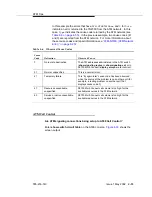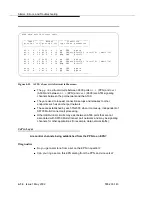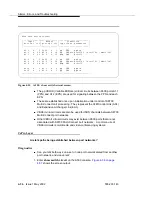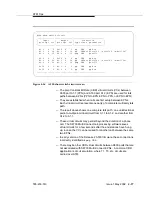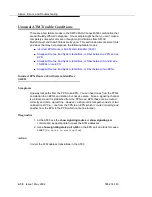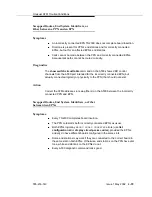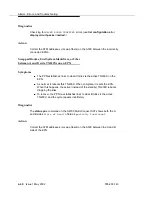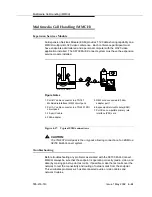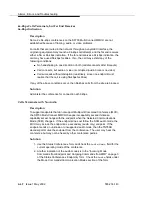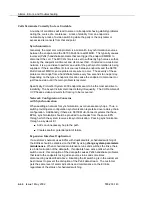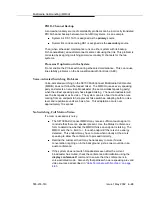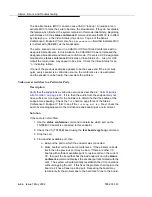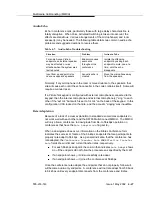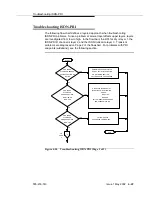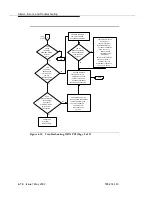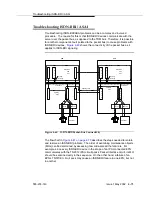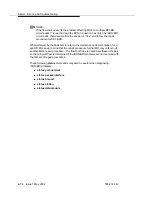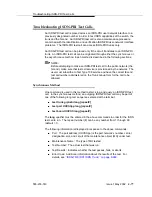
Multimedia Call Handling (MMCH)
Issue 1 May 2002
4-67
555-233-143
Audio Echo
Echo in conference calls, particularly those with large delay characteristics, is
totally disruptive. When Voice Activated Switching is taken into account, the
effects are disastrous. Various arrangements of the microphone(s) and room
speaker(s) may be needed. The following table details two common audio echo
problems and suggested actions to resolve them.
Normally, if any microphone in the room is moved relative to the speakers, that
site will cause echo until the echo canceller in the codec retrains itself. Some will
require a manual reset.
If a PictureTel keypad is configured with external microphones connected to the
keypad, then the internal microphone and external microphone(s) “sing” to each
other if the “ext mic” bat switch is set to “int mic” on the back of the keypad. In this
configuration, VAS locked on that site, and the acoustic “singing” was inaudible.
Rate Adaptation
Because of a lack of a clear explanation in standards, sometimes endpoints do
not work well with each other and the S8700 Multi-Connect MMCH. The MMCH
will only allow a conference to downgrade from 64- to 56-kbps operation on
conferences that have the
Rate Adaptation
flag set to
y
.
When a downgrade does occur, information on the Status Conference form
indicates the success or failure of the 64-kbps endpoints that are participants to
properly rate adapt to 56 kbps. As a general indication that the conference has
rate adapted, the
Conference Transfer Rate
and
Effective Transfer
Rate
fields show initial and current transfer rates, respectively.
■
For each 64-kbps endpoint, the column that indicates
Rate Adapt
shows
an
n
if the endpoint did not follow the procedures as specified by the H.221.
■
If an endpoint shows
y
, it did successfully rate adapt.
■
If an endpoint shows
c
, it joined the conference at 56 kbps.
Once the conference rate adapts, the endpoints that do not properly follow suit,
will become audio-only endpoints. A conference will not rate adapt from 56 back
to 64 kbps until every endpoint disconnects from the conference and it idles.
Table 4-7.
Audio Echo Troubleshooting
Situation
Problem
Action to Take
For some Avaya Vistium
endpoints, an external speaker
may be attached or was
attached when the system was
last rebooted
Endpoint causes
audio echo
throughout the
conference
Isolate the offending
endpoint by asking each
endpoint to mute, one at a
time, until the echo
disappears.
Input from an endpoint is too
near an endpoint’s speakers
Acoustic echo is
created
Move the microphone away
from the speakers.
Summary of Contents for S8700 Series
Page 50: ...Maintenance Architecture 555 233 143 1 26 Issue 1 May 2002 ...
Page 74: ...Initialization and Recovery 555 233 143 3 12 Issue 1 May 2002 ...
Page 186: ...Alarms Errors and Troubleshooting 555 233 143 4 112 Issue 1 May 2002 ...
Page 232: ...Additional Maintenance Procedures 555 233 143 5 46 Issue 1 May 2002 ...
Page 635: ...status psa Issue 1 May 2002 7 379 555 233 143 status psa See status tti on page 7 406 ...
Page 722: ...Maintenance Commands 555 233 143 7 466 Issue 1 May 2002 ...

